Project Management Practices: Opera House Case Study Report Analysis
VerifiedAdded on 2022/08/25
|14
|3238
|15
Report
AI Summary
This report presents a detailed case study analysis of the Sydney Opera House construction project, examining the factors that contributed to its significant cost and time overruns. The introduction provides a brief overview of the project, its initial goals, and the eventual outcome, highlighting the project's status as a global icon and a construction disaster. The report explores the project's motivation, ultimate goals, and the initial plan, including the three stages of construction: podium, outer shell, and interior. Problem descriptions detail the challenges encountered, such as changing requirements, lack of experienced project management, and government interference. The research methodology, primarily observational analysis of the case study, is described, followed by data collection methods and a detailed data analysis section. Findings reveal issues in time, cost, and quality management, along with the absence of crucial project management elements like a risk management plan and a Work Breakdown Structure (WBS). The report concludes with recommendations for improved project management practices, emphasizing the importance of clearly defined objectives, effective stakeholder management, and proactive risk mitigation strategies. This analysis underscores the critical role of project managers in ensuring project success by addressing scope, cost, and risk management effectively.
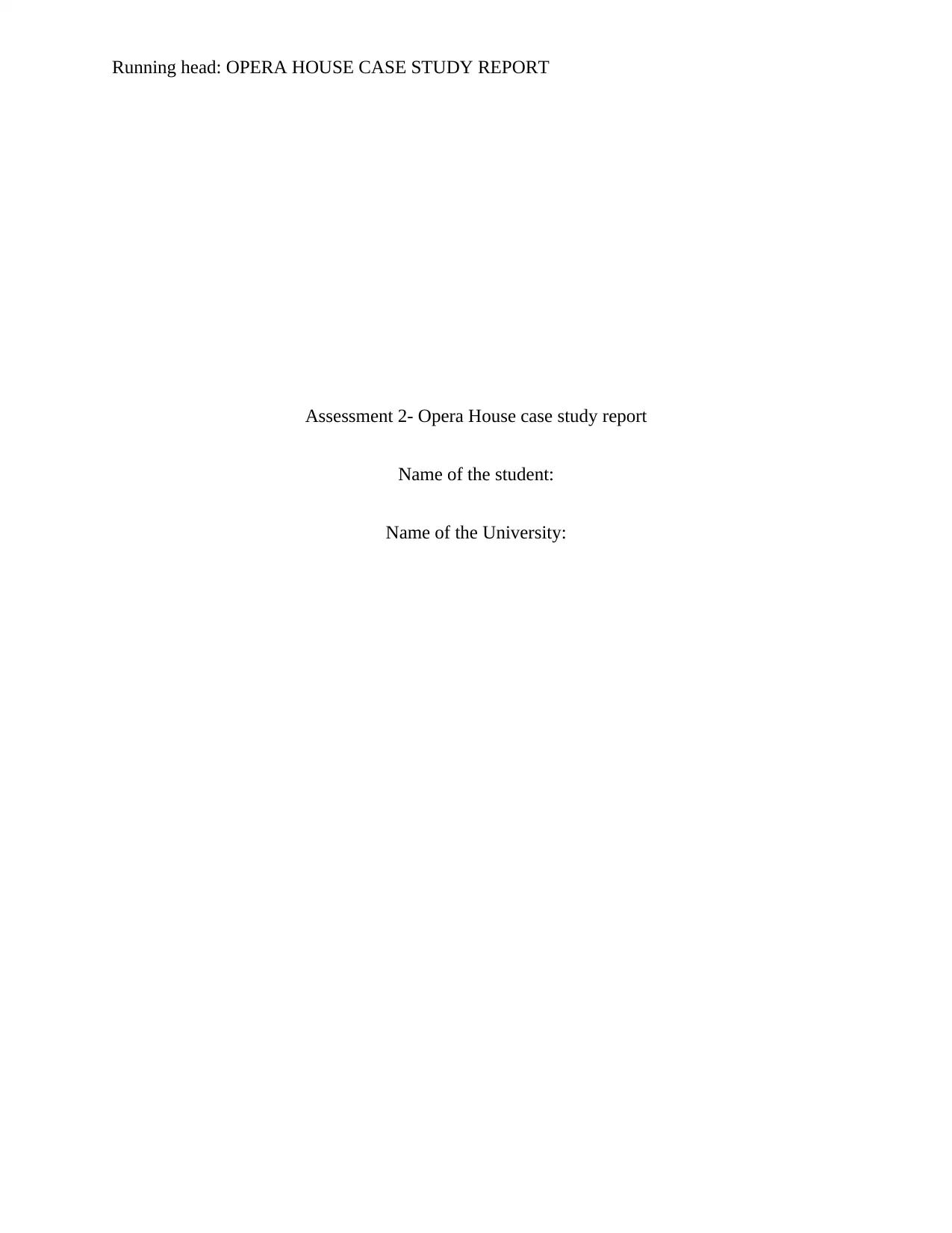
Running head: OPERA HOUSE CASE STUDY REPORT
Assessment 2- Opera House case study report
Name of the student:
Name of the University:
Assessment 2- Opera House case study report
Name of the student:
Name of the University:
Paraphrase This Document
Need a fresh take? Get an instant paraphrase of this document with our AI Paraphraser
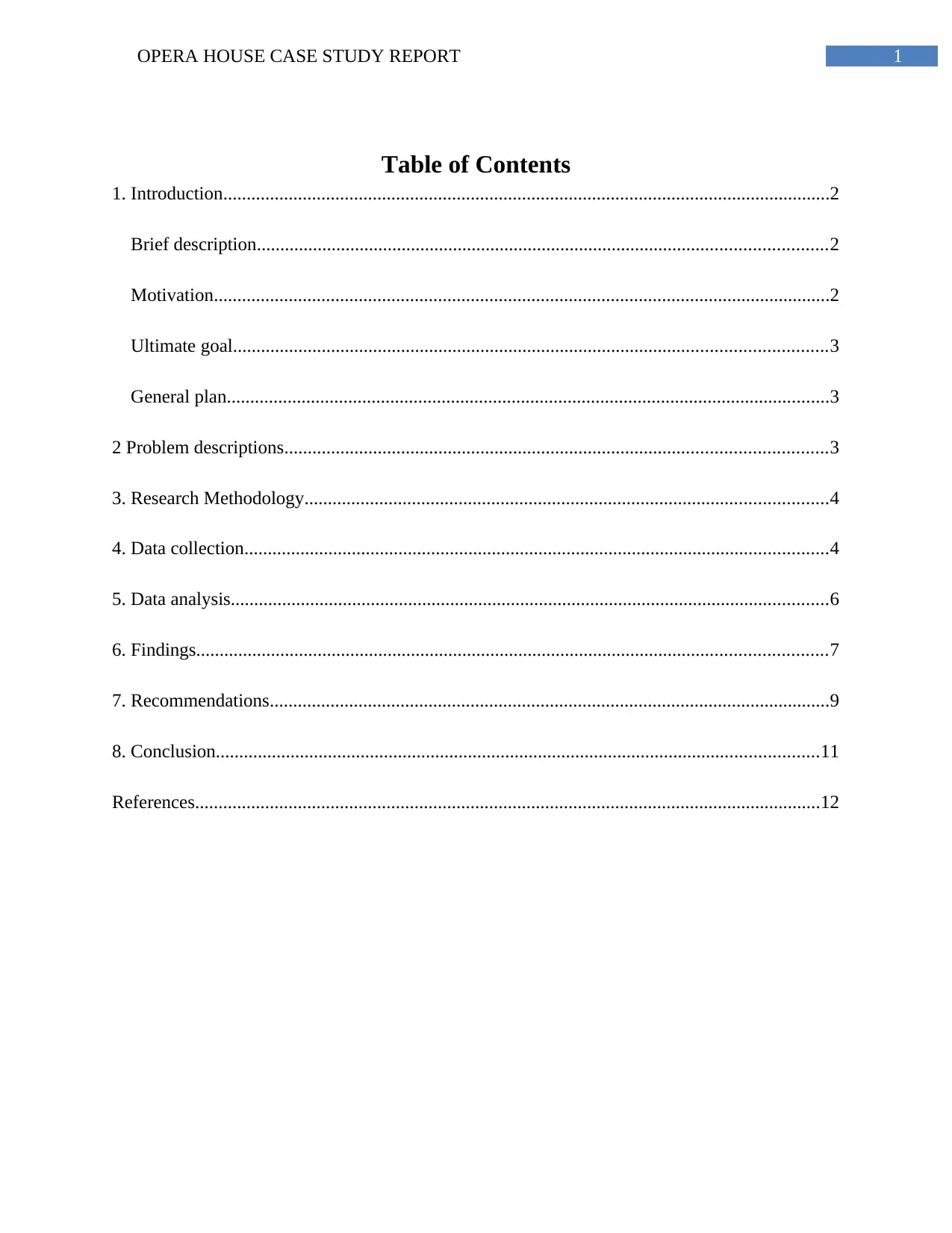
1OPERA HOUSE CASE STUDY REPORT
Table of Contents
1. Introduction..................................................................................................................................2
Brief description..........................................................................................................................2
Motivation....................................................................................................................................2
Ultimate goal...............................................................................................................................3
General plan.................................................................................................................................3
2 Problem descriptions....................................................................................................................3
3. Research Methodology................................................................................................................4
4. Data collection.............................................................................................................................4
5. Data analysis................................................................................................................................6
6. Findings.......................................................................................................................................7
7. Recommendations........................................................................................................................9
8. Conclusion.................................................................................................................................11
References......................................................................................................................................12
Table of Contents
1. Introduction..................................................................................................................................2
Brief description..........................................................................................................................2
Motivation....................................................................................................................................2
Ultimate goal...............................................................................................................................3
General plan.................................................................................................................................3
2 Problem descriptions....................................................................................................................3
3. Research Methodology................................................................................................................4
4. Data collection.............................................................................................................................4
5. Data analysis................................................................................................................................6
6. Findings.......................................................................................................................................7
7. Recommendations........................................................................................................................9
8. Conclusion.................................................................................................................................11
References......................................................................................................................................12
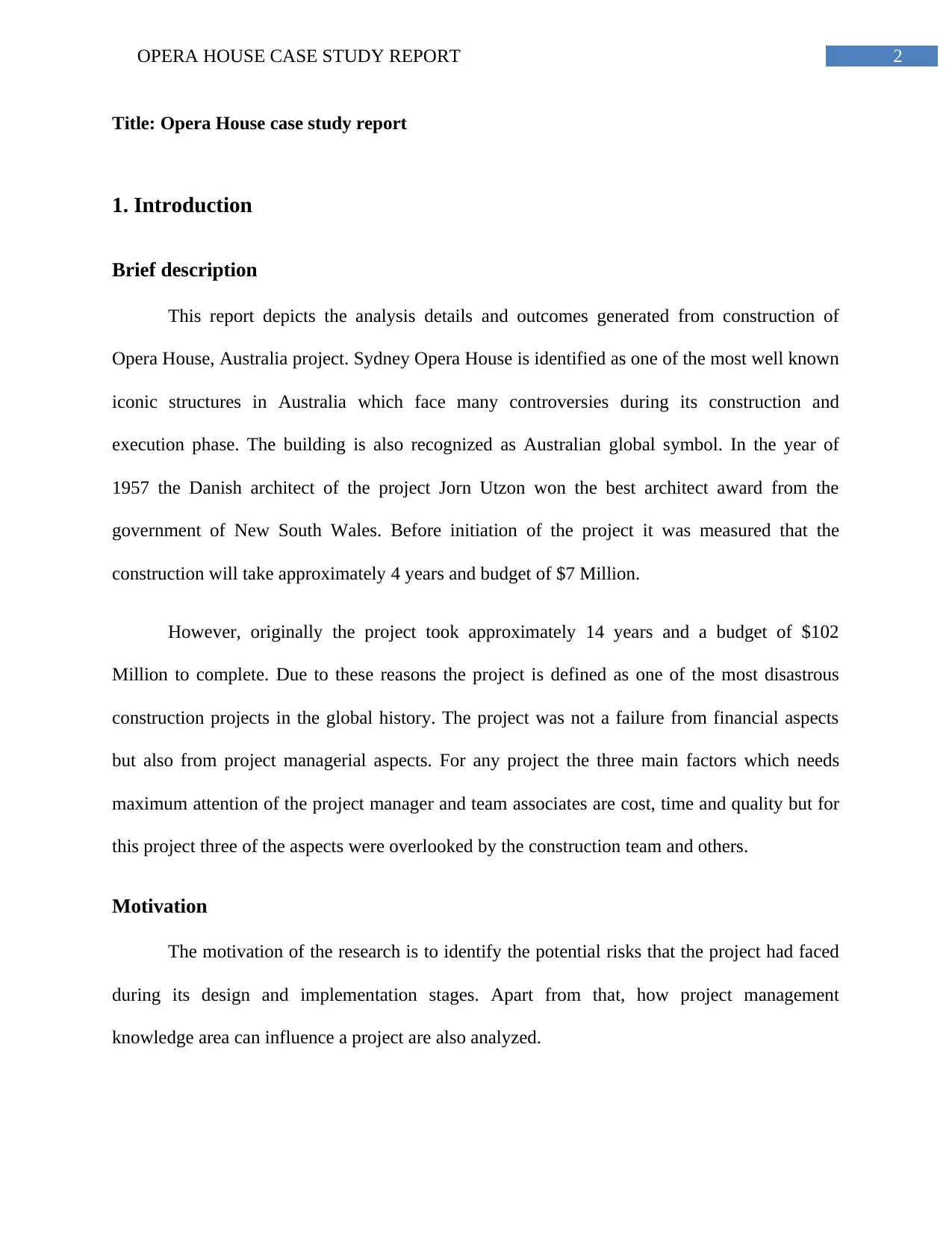
2OPERA HOUSE CASE STUDY REPORT
Title: Opera House case study report
1. Introduction
Brief description
This report depicts the analysis details and outcomes generated from construction of
Opera House, Australia project. Sydney Opera House is identified as one of the most well known
iconic structures in Australia which face many controversies during its construction and
execution phase. The building is also recognized as Australian global symbol. In the year of
1957 the Danish architect of the project Jorn Utzon won the best architect award from the
government of New South Wales. Before initiation of the project it was measured that the
construction will take approximately 4 years and budget of $7 Million.
However, originally the project took approximately 14 years and a budget of $102
Million to complete. Due to these reasons the project is defined as one of the most disastrous
construction projects in the global history. The project was not a failure from financial aspects
but also from project managerial aspects. For any project the three main factors which needs
maximum attention of the project manager and team associates are cost, time and quality but for
this project three of the aspects were overlooked by the construction team and others.
Motivation
The motivation of the research is to identify the potential risks that the project had faced
during its design and implementation stages. Apart from that, how project management
knowledge area can influence a project are also analyzed.
Title: Opera House case study report
1. Introduction
Brief description
This report depicts the analysis details and outcomes generated from construction of
Opera House, Australia project. Sydney Opera House is identified as one of the most well known
iconic structures in Australia which face many controversies during its construction and
execution phase. The building is also recognized as Australian global symbol. In the year of
1957 the Danish architect of the project Jorn Utzon won the best architect award from the
government of New South Wales. Before initiation of the project it was measured that the
construction will take approximately 4 years and budget of $7 Million.
However, originally the project took approximately 14 years and a budget of $102
Million to complete. Due to these reasons the project is defined as one of the most disastrous
construction projects in the global history. The project was not a failure from financial aspects
but also from project managerial aspects. For any project the three main factors which needs
maximum attention of the project manager and team associates are cost, time and quality but for
this project three of the aspects were overlooked by the construction team and others.
Motivation
The motivation of the research is to identify the potential risks that the project had faced
during its design and implementation stages. Apart from that, how project management
knowledge area can influence a project are also analyzed.
⊘ This is a preview!⊘
Do you want full access?
Subscribe today to unlock all pages.

Trusted by 1+ million students worldwide
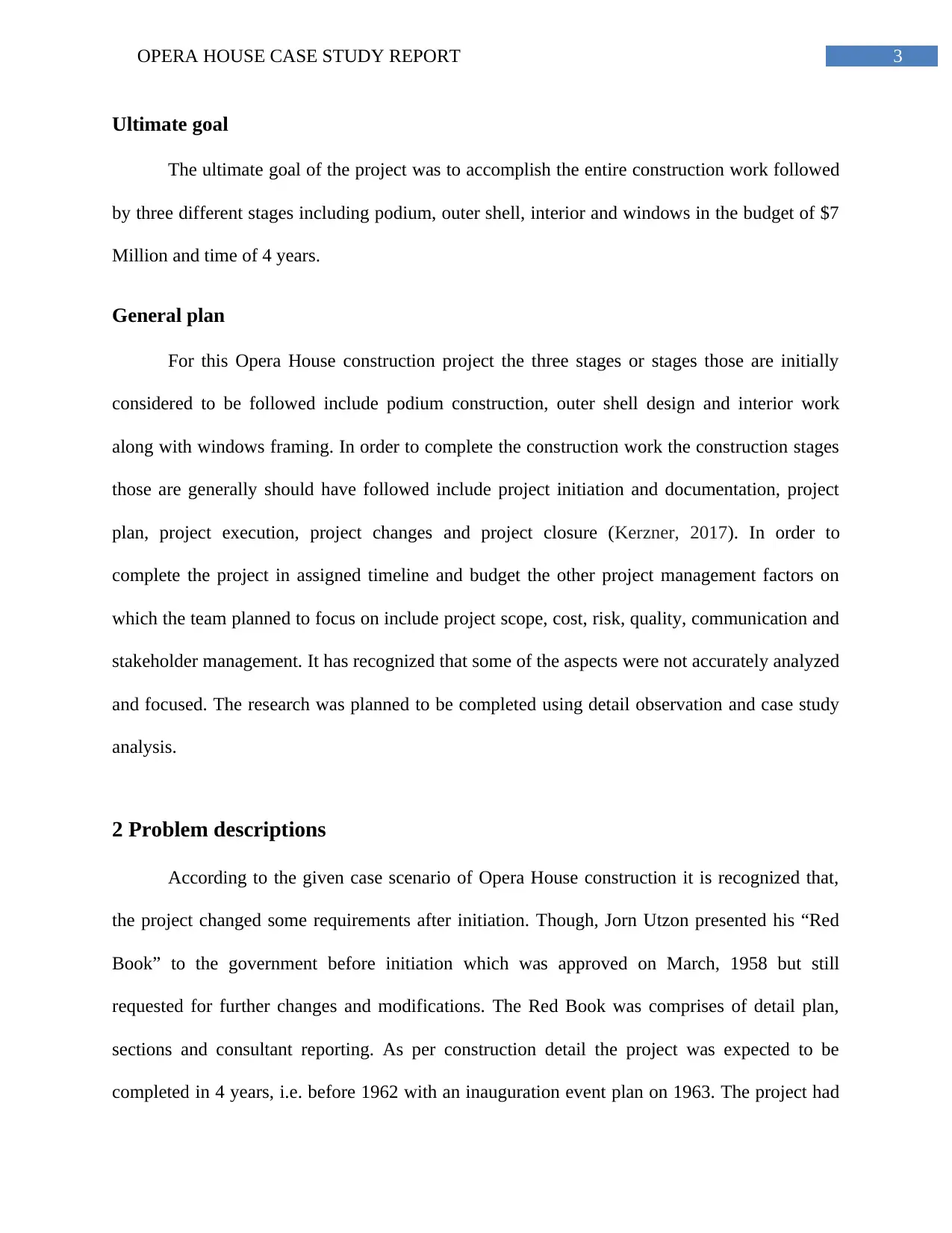
3OPERA HOUSE CASE STUDY REPORT
Ultimate goal
The ultimate goal of the project was to accomplish the entire construction work followed
by three different stages including podium, outer shell, interior and windows in the budget of $7
Million and time of 4 years.
General plan
For this Opera House construction project the three stages or stages those are initially
considered to be followed include podium construction, outer shell design and interior work
along with windows framing. In order to complete the construction work the construction stages
those are generally should have followed include project initiation and documentation, project
plan, project execution, project changes and project closure (Kerzner, 2017). In order to
complete the project in assigned timeline and budget the other project management factors on
which the team planned to focus on include project scope, cost, risk, quality, communication and
stakeholder management. It has recognized that some of the aspects were not accurately analyzed
and focused. The research was planned to be completed using detail observation and case study
analysis.
2 Problem descriptions
According to the given case scenario of Opera House construction it is recognized that,
the project changed some requirements after initiation. Though, Jorn Utzon presented his “Red
Book” to the government before initiation which was approved on March, 1958 but still
requested for further changes and modifications. The Red Book was comprises of detail plan,
sections and consultant reporting. As per construction detail the project was expected to be
completed in 4 years, i.e. before 1962 with an inauguration event plan on 1963. The project had
Ultimate goal
The ultimate goal of the project was to accomplish the entire construction work followed
by three different stages including podium, outer shell, interior and windows in the budget of $7
Million and time of 4 years.
General plan
For this Opera House construction project the three stages or stages those are initially
considered to be followed include podium construction, outer shell design and interior work
along with windows framing. In order to complete the construction work the construction stages
those are generally should have followed include project initiation and documentation, project
plan, project execution, project changes and project closure (Kerzner, 2017). In order to
complete the project in assigned timeline and budget the other project management factors on
which the team planned to focus on include project scope, cost, risk, quality, communication and
stakeholder management. It has recognized that some of the aspects were not accurately analyzed
and focused. The research was planned to be completed using detail observation and case study
analysis.
2 Problem descriptions
According to the given case scenario of Opera House construction it is recognized that,
the project changed some requirements after initiation. Though, Jorn Utzon presented his “Red
Book” to the government before initiation which was approved on March, 1958 but still
requested for further changes and modifications. The Red Book was comprises of detail plan,
sections and consultant reporting. As per construction detail the project was expected to be
completed in 4 years, i.e. before 1962 with an inauguration event plan on 1963. The project had
Paraphrase This Document
Need a fresh take? Get an instant paraphrase of this document with our AI Paraphraser
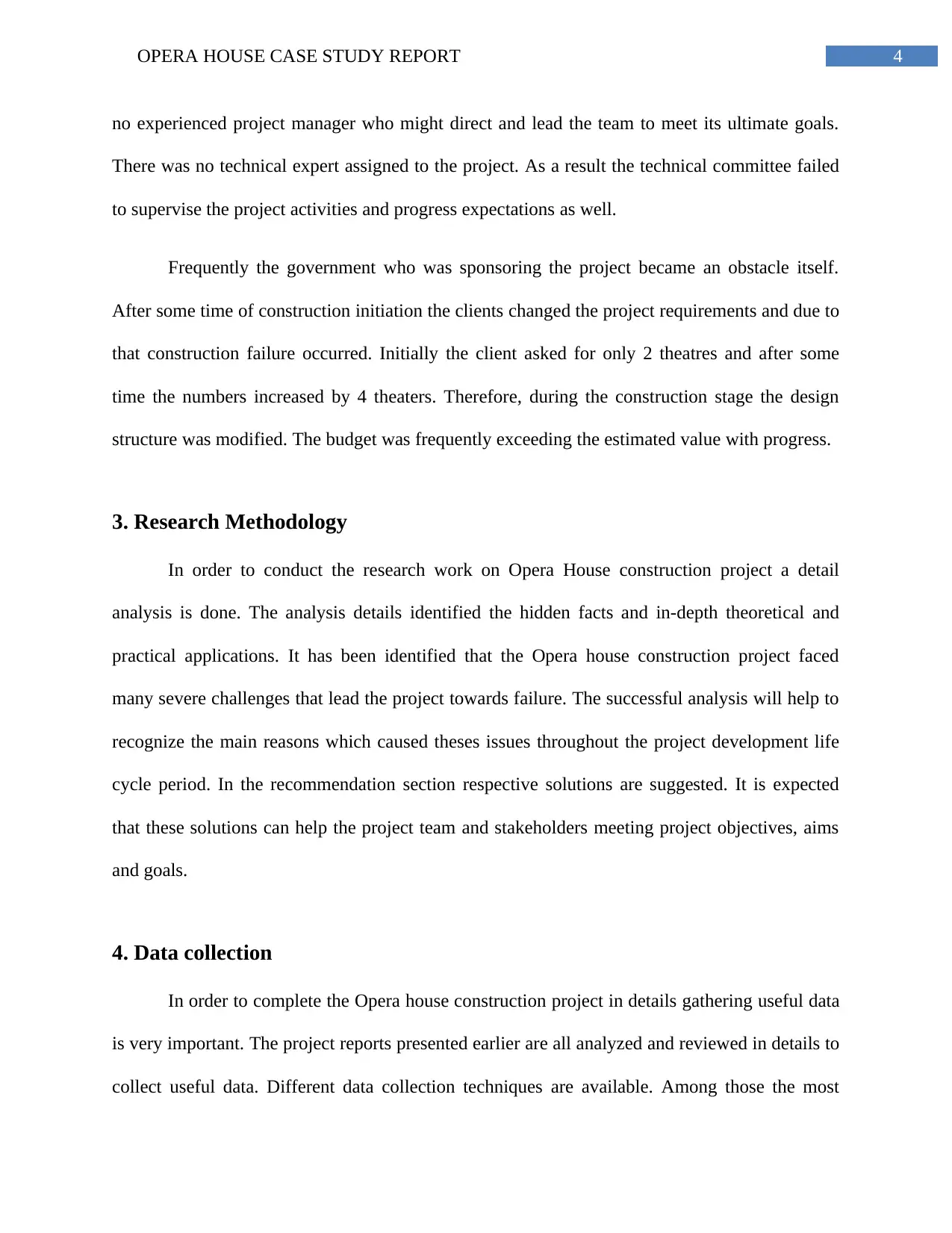
4OPERA HOUSE CASE STUDY REPORT
no experienced project manager who might direct and lead the team to meet its ultimate goals.
There was no technical expert assigned to the project. As a result the technical committee failed
to supervise the project activities and progress expectations as well.
Frequently the government who was sponsoring the project became an obstacle itself.
After some time of construction initiation the clients changed the project requirements and due to
that construction failure occurred. Initially the client asked for only 2 theatres and after some
time the numbers increased by 4 theaters. Therefore, during the construction stage the design
structure was modified. The budget was frequently exceeding the estimated value with progress.
3. Research Methodology
In order to conduct the research work on Opera House construction project a detail
analysis is done. The analysis details identified the hidden facts and in-depth theoretical and
practical applications. It has been identified that the Opera house construction project faced
many severe challenges that lead the project towards failure. The successful analysis will help to
recognize the main reasons which caused theses issues throughout the project development life
cycle period. In the recommendation section respective solutions are suggested. It is expected
that these solutions can help the project team and stakeholders meeting project objectives, aims
and goals.
4. Data collection
In order to complete the Opera house construction project in details gathering useful data
is very important. The project reports presented earlier are all analyzed and reviewed in details to
collect useful data. Different data collection techniques are available. Among those the most
no experienced project manager who might direct and lead the team to meet its ultimate goals.
There was no technical expert assigned to the project. As a result the technical committee failed
to supervise the project activities and progress expectations as well.
Frequently the government who was sponsoring the project became an obstacle itself.
After some time of construction initiation the clients changed the project requirements and due to
that construction failure occurred. Initially the client asked for only 2 theatres and after some
time the numbers increased by 4 theaters. Therefore, during the construction stage the design
structure was modified. The budget was frequently exceeding the estimated value with progress.
3. Research Methodology
In order to conduct the research work on Opera House construction project a detail
analysis is done. The analysis details identified the hidden facts and in-depth theoretical and
practical applications. It has been identified that the Opera house construction project faced
many severe challenges that lead the project towards failure. The successful analysis will help to
recognize the main reasons which caused theses issues throughout the project development life
cycle period. In the recommendation section respective solutions are suggested. It is expected
that these solutions can help the project team and stakeholders meeting project objectives, aims
and goals.
4. Data collection
In order to complete the Opera house construction project in details gathering useful data
is very important. The project reports presented earlier are all analyzed and reviewed in details to
collect useful data. Different data collection techniques are available. Among those the most
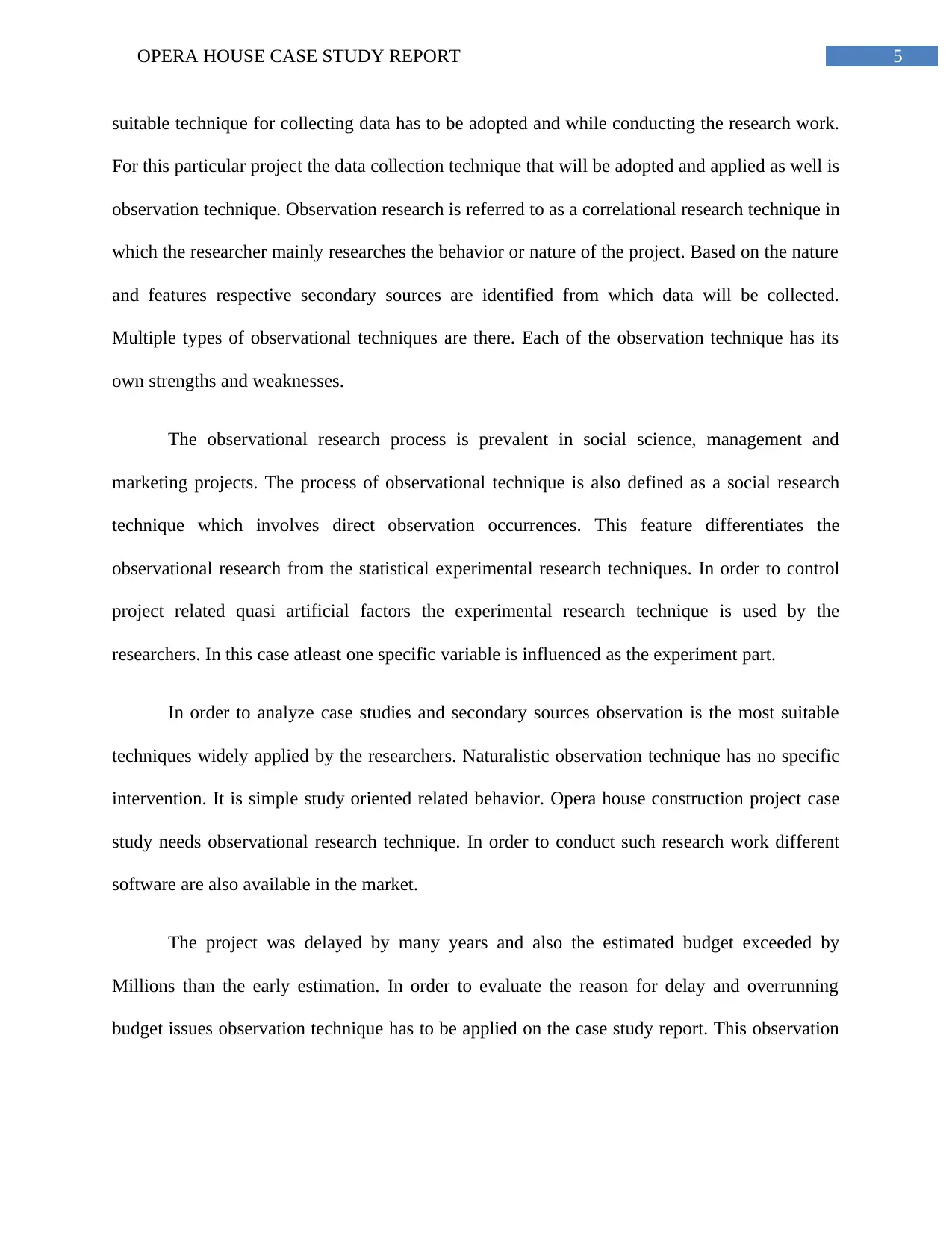
5OPERA HOUSE CASE STUDY REPORT
suitable technique for collecting data has to be adopted and while conducting the research work.
For this particular project the data collection technique that will be adopted and applied as well is
observation technique. Observation research is referred to as a correlational research technique in
which the researcher mainly researches the behavior or nature of the project. Based on the nature
and features respective secondary sources are identified from which data will be collected.
Multiple types of observational techniques are there. Each of the observation technique has its
own strengths and weaknesses.
The observational research process is prevalent in social science, management and
marketing projects. The process of observational technique is also defined as a social research
technique which involves direct observation occurrences. This feature differentiates the
observational research from the statistical experimental research techniques. In order to control
project related quasi artificial factors the experimental research technique is used by the
researchers. In this case atleast one specific variable is influenced as the experiment part.
In order to analyze case studies and secondary sources observation is the most suitable
techniques widely applied by the researchers. Naturalistic observation technique has no specific
intervention. It is simple study oriented related behavior. Opera house construction project case
study needs observational research technique. In order to conduct such research work different
software are also available in the market.
The project was delayed by many years and also the estimated budget exceeded by
Millions than the early estimation. In order to evaluate the reason for delay and overrunning
budget issues observation technique has to be applied on the case study report. This observation
suitable technique for collecting data has to be adopted and while conducting the research work.
For this particular project the data collection technique that will be adopted and applied as well is
observation technique. Observation research is referred to as a correlational research technique in
which the researcher mainly researches the behavior or nature of the project. Based on the nature
and features respective secondary sources are identified from which data will be collected.
Multiple types of observational techniques are there. Each of the observation technique has its
own strengths and weaknesses.
The observational research process is prevalent in social science, management and
marketing projects. The process of observational technique is also defined as a social research
technique which involves direct observation occurrences. This feature differentiates the
observational research from the statistical experimental research techniques. In order to control
project related quasi artificial factors the experimental research technique is used by the
researchers. In this case atleast one specific variable is influenced as the experiment part.
In order to analyze case studies and secondary sources observation is the most suitable
techniques widely applied by the researchers. Naturalistic observation technique has no specific
intervention. It is simple study oriented related behavior. Opera house construction project case
study needs observational research technique. In order to conduct such research work different
software are also available in the market.
The project was delayed by many years and also the estimated budget exceeded by
Millions than the early estimation. In order to evaluate the reason for delay and overrunning
budget issues observation technique has to be applied on the case study report. This observation
⊘ This is a preview!⊘
Do you want full access?
Subscribe today to unlock all pages.

Trusted by 1+ million students worldwide
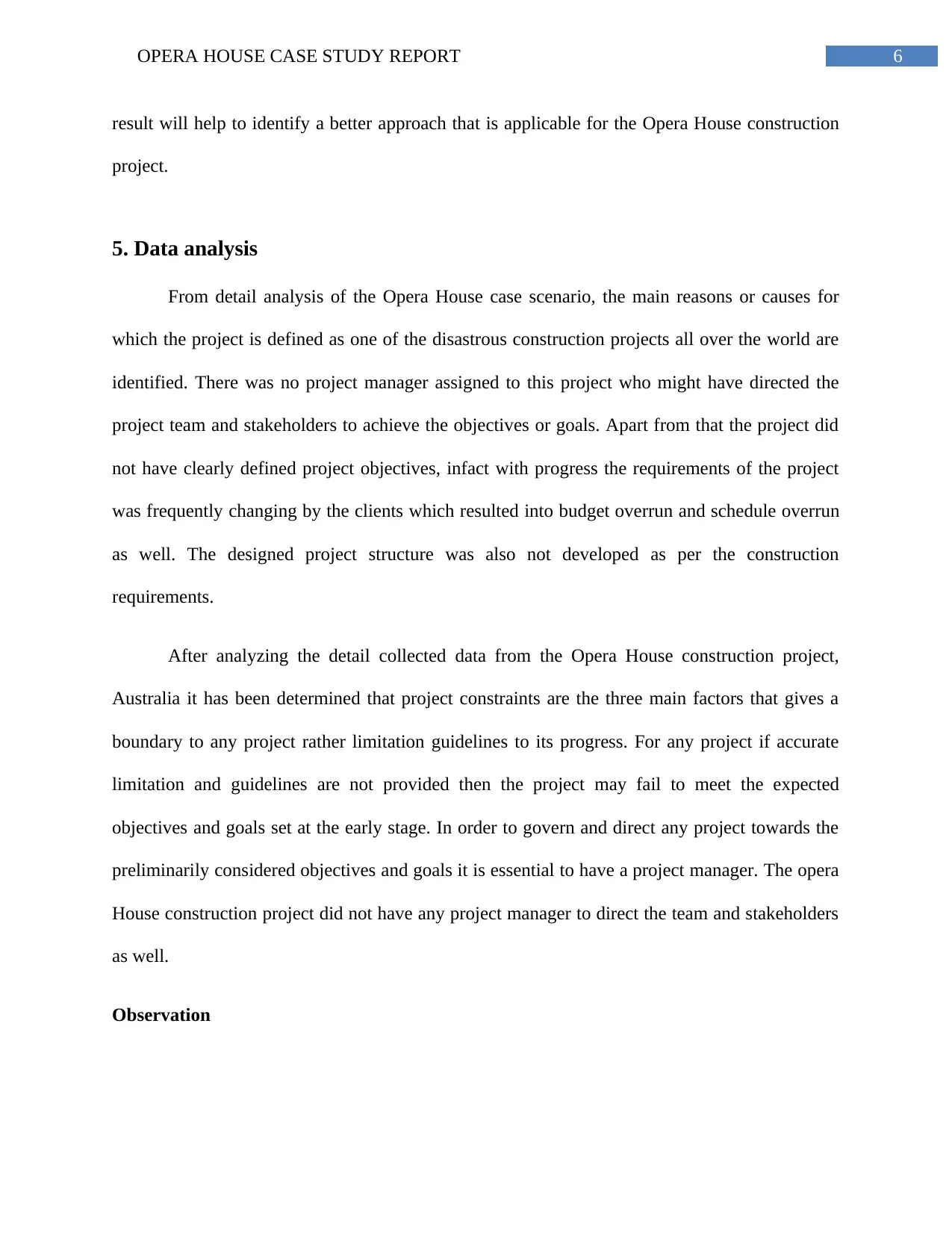
6OPERA HOUSE CASE STUDY REPORT
result will help to identify a better approach that is applicable for the Opera House construction
project.
5. Data analysis
From detail analysis of the Opera House case scenario, the main reasons or causes for
which the project is defined as one of the disastrous construction projects all over the world are
identified. There was no project manager assigned to this project who might have directed the
project team and stakeholders to achieve the objectives or goals. Apart from that the project did
not have clearly defined project objectives, infact with progress the requirements of the project
was frequently changing by the clients which resulted into budget overrun and schedule overrun
as well. The designed project structure was also not developed as per the construction
requirements.
After analyzing the detail collected data from the Opera House construction project,
Australia it has been determined that project constraints are the three main factors that gives a
boundary to any project rather limitation guidelines to its progress. For any project if accurate
limitation and guidelines are not provided then the project may fail to meet the expected
objectives and goals set at the early stage. In order to govern and direct any project towards the
preliminarily considered objectives and goals it is essential to have a project manager. The opera
House construction project did not have any project manager to direct the team and stakeholders
as well.
Observation
result will help to identify a better approach that is applicable for the Opera House construction
project.
5. Data analysis
From detail analysis of the Opera House case scenario, the main reasons or causes for
which the project is defined as one of the disastrous construction projects all over the world are
identified. There was no project manager assigned to this project who might have directed the
project team and stakeholders to achieve the objectives or goals. Apart from that the project did
not have clearly defined project objectives, infact with progress the requirements of the project
was frequently changing by the clients which resulted into budget overrun and schedule overrun
as well. The designed project structure was also not developed as per the construction
requirements.
After analyzing the detail collected data from the Opera House construction project,
Australia it has been determined that project constraints are the three main factors that gives a
boundary to any project rather limitation guidelines to its progress. For any project if accurate
limitation and guidelines are not provided then the project may fail to meet the expected
objectives and goals set at the early stage. In order to govern and direct any project towards the
preliminarily considered objectives and goals it is essential to have a project manager. The opera
House construction project did not have any project manager to direct the team and stakeholders
as well.
Observation
Paraphrase This Document
Need a fresh take? Get an instant paraphrase of this document with our AI Paraphraser
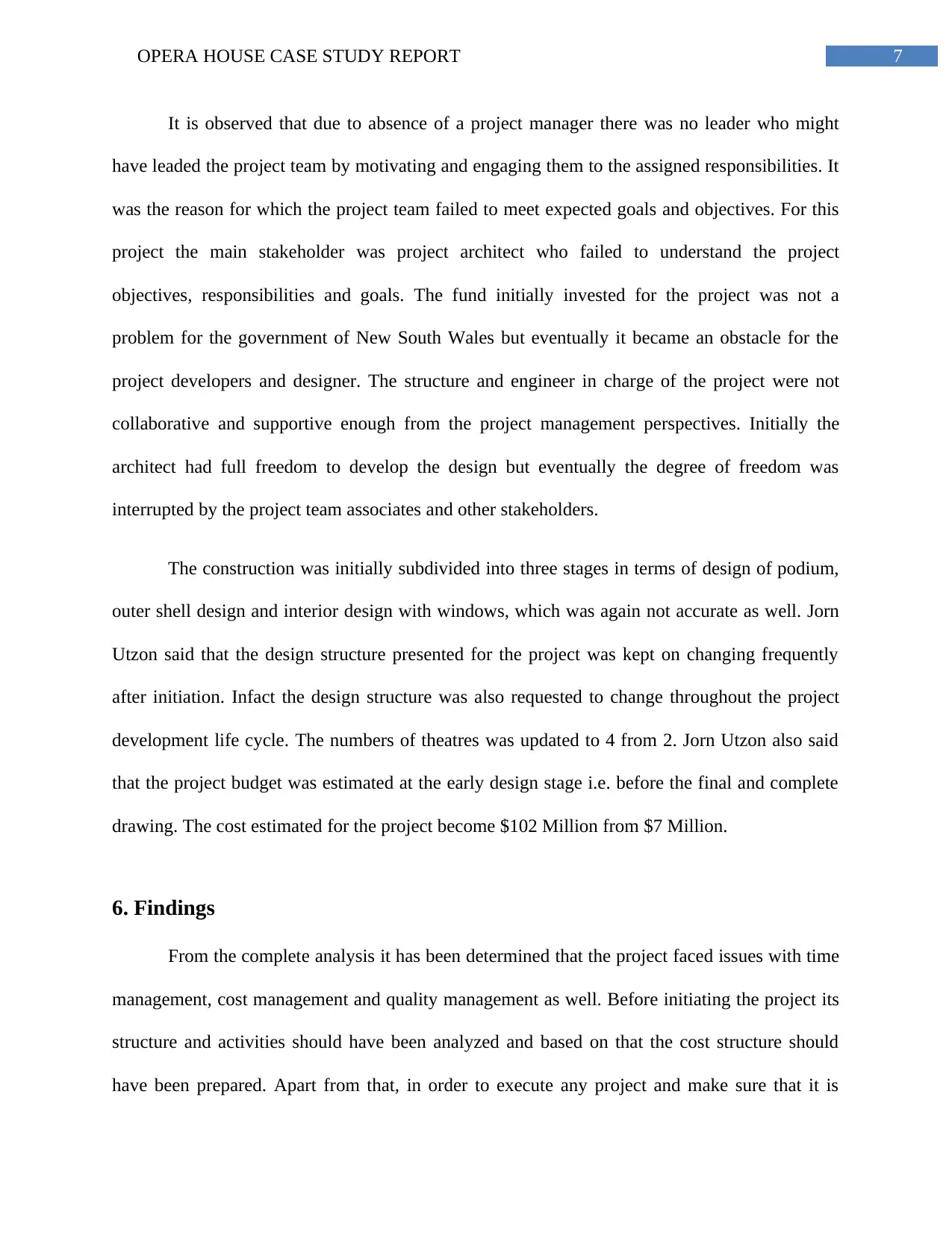
7OPERA HOUSE CASE STUDY REPORT
It is observed that due to absence of a project manager there was no leader who might
have leaded the project team by motivating and engaging them to the assigned responsibilities. It
was the reason for which the project team failed to meet expected goals and objectives. For this
project the main stakeholder was project architect who failed to understand the project
objectives, responsibilities and goals. The fund initially invested for the project was not a
problem for the government of New South Wales but eventually it became an obstacle for the
project developers and designer. The structure and engineer in charge of the project were not
collaborative and supportive enough from the project management perspectives. Initially the
architect had full freedom to develop the design but eventually the degree of freedom was
interrupted by the project team associates and other stakeholders.
The construction was initially subdivided into three stages in terms of design of podium,
outer shell design and interior design with windows, which was again not accurate as well. Jorn
Utzon said that the design structure presented for the project was kept on changing frequently
after initiation. Infact the design structure was also requested to change throughout the project
development life cycle. The numbers of theatres was updated to 4 from 2. Jorn Utzon also said
that the project budget was estimated at the early design stage i.e. before the final and complete
drawing. The cost estimated for the project become $102 Million from $7 Million.
6. Findings
From the complete analysis it has been determined that the project faced issues with time
management, cost management and quality management as well. Before initiating the project its
structure and activities should have been analyzed and based on that the cost structure should
have been prepared. Apart from that, in order to execute any project and make sure that it is
It is observed that due to absence of a project manager there was no leader who might
have leaded the project team by motivating and engaging them to the assigned responsibilities. It
was the reason for which the project team failed to meet expected goals and objectives. For this
project the main stakeholder was project architect who failed to understand the project
objectives, responsibilities and goals. The fund initially invested for the project was not a
problem for the government of New South Wales but eventually it became an obstacle for the
project developers and designer. The structure and engineer in charge of the project were not
collaborative and supportive enough from the project management perspectives. Initially the
architect had full freedom to develop the design but eventually the degree of freedom was
interrupted by the project team associates and other stakeholders.
The construction was initially subdivided into three stages in terms of design of podium,
outer shell design and interior design with windows, which was again not accurate as well. Jorn
Utzon said that the design structure presented for the project was kept on changing frequently
after initiation. Infact the design structure was also requested to change throughout the project
development life cycle. The numbers of theatres was updated to 4 from 2. Jorn Utzon also said
that the project budget was estimated at the early design stage i.e. before the final and complete
drawing. The cost estimated for the project become $102 Million from $7 Million.
6. Findings
From the complete analysis it has been determined that the project faced issues with time
management, cost management and quality management as well. Before initiating the project its
structure and activities should have been analyzed and based on that the cost structure should
have been prepared. Apart from that, in order to execute any project and make sure that it is
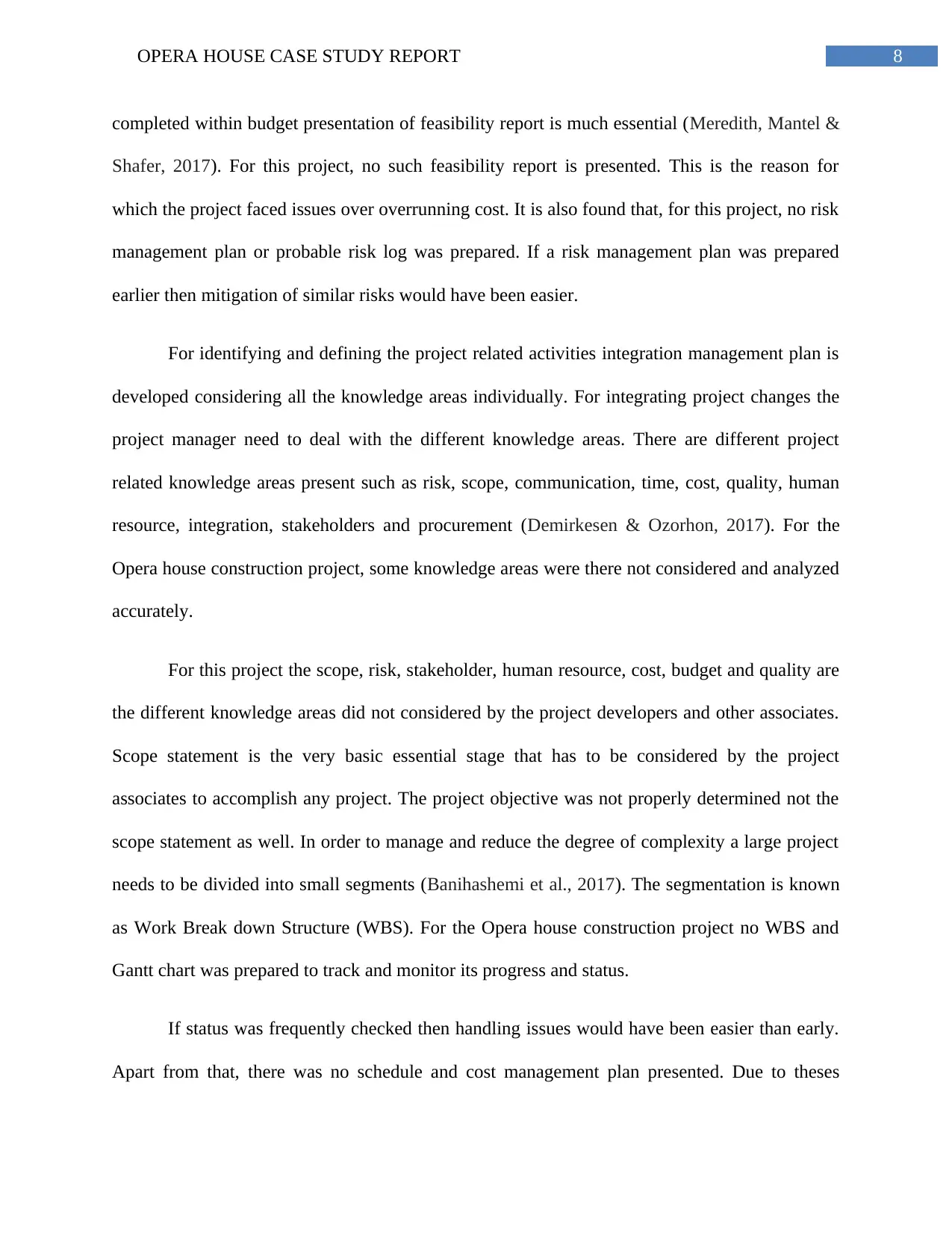
8OPERA HOUSE CASE STUDY REPORT
completed within budget presentation of feasibility report is much essential (Meredith, Mantel &
Shafer, 2017). For this project, no such feasibility report is presented. This is the reason for
which the project faced issues over overrunning cost. It is also found that, for this project, no risk
management plan or probable risk log was prepared. If a risk management plan was prepared
earlier then mitigation of similar risks would have been easier.
For identifying and defining the project related activities integration management plan is
developed considering all the knowledge areas individually. For integrating project changes the
project manager need to deal with the different knowledge areas. There are different project
related knowledge areas present such as risk, scope, communication, time, cost, quality, human
resource, integration, stakeholders and procurement (Demirkesen & Ozorhon, 2017). For the
Opera house construction project, some knowledge areas were there not considered and analyzed
accurately.
For this project the scope, risk, stakeholder, human resource, cost, budget and quality are
the different knowledge areas did not considered by the project developers and other associates.
Scope statement is the very basic essential stage that has to be considered by the project
associates to accomplish any project. The project objective was not properly determined not the
scope statement as well. In order to manage and reduce the degree of complexity a large project
needs to be divided into small segments (Banihashemi et al., 2017). The segmentation is known
as Work Break down Structure (WBS). For the Opera house construction project no WBS and
Gantt chart was prepared to track and monitor its progress and status.
If status was frequently checked then handling issues would have been easier than early.
Apart from that, there was no schedule and cost management plan presented. Due to theses
completed within budget presentation of feasibility report is much essential (Meredith, Mantel &
Shafer, 2017). For this project, no such feasibility report is presented. This is the reason for
which the project faced issues over overrunning cost. It is also found that, for this project, no risk
management plan or probable risk log was prepared. If a risk management plan was prepared
earlier then mitigation of similar risks would have been easier.
For identifying and defining the project related activities integration management plan is
developed considering all the knowledge areas individually. For integrating project changes the
project manager need to deal with the different knowledge areas. There are different project
related knowledge areas present such as risk, scope, communication, time, cost, quality, human
resource, integration, stakeholders and procurement (Demirkesen & Ozorhon, 2017). For the
Opera house construction project, some knowledge areas were there not considered and analyzed
accurately.
For this project the scope, risk, stakeholder, human resource, cost, budget and quality are
the different knowledge areas did not considered by the project developers and other associates.
Scope statement is the very basic essential stage that has to be considered by the project
associates to accomplish any project. The project objective was not properly determined not the
scope statement as well. In order to manage and reduce the degree of complexity a large project
needs to be divided into small segments (Banihashemi et al., 2017). The segmentation is known
as Work Break down Structure (WBS). For the Opera house construction project no WBS and
Gantt chart was prepared to track and monitor its progress and status.
If status was frequently checked then handling issues would have been easier than early.
Apart from that, there was no schedule and cost management plan presented. Due to theses
⊘ This is a preview!⊘
Do you want full access?
Subscribe today to unlock all pages.

Trusted by 1+ million students worldwide
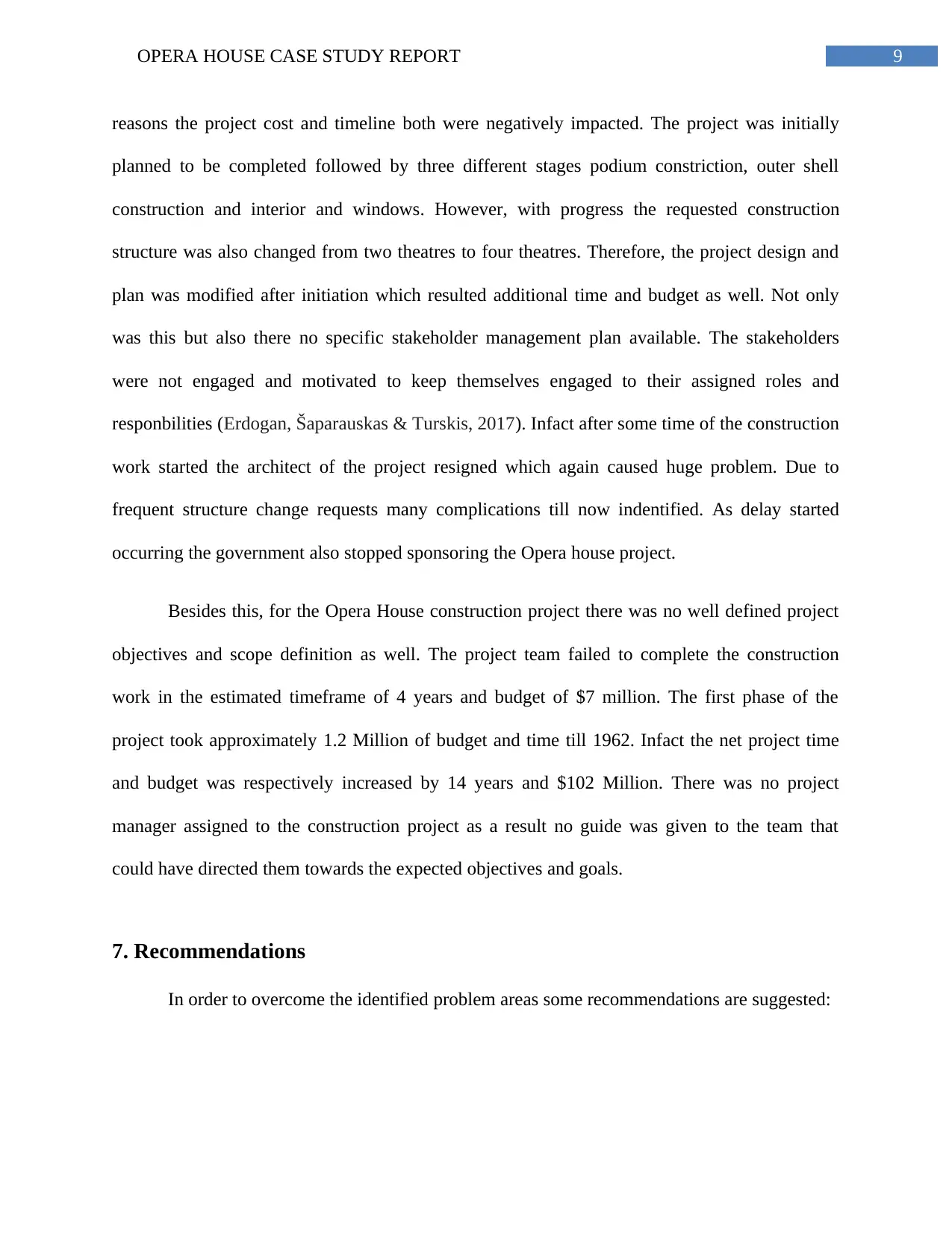
9OPERA HOUSE CASE STUDY REPORT
reasons the project cost and timeline both were negatively impacted. The project was initially
planned to be completed followed by three different stages podium constriction, outer shell
construction and interior and windows. However, with progress the requested construction
structure was also changed from two theatres to four theatres. Therefore, the project design and
plan was modified after initiation which resulted additional time and budget as well. Not only
was this but also there no specific stakeholder management plan available. The stakeholders
were not engaged and motivated to keep themselves engaged to their assigned roles and
responbilities (Erdogan, Šaparauskas & Turskis, 2017). Infact after some time of the construction
work started the architect of the project resigned which again caused huge problem. Due to
frequent structure change requests many complications till now indentified. As delay started
occurring the government also stopped sponsoring the Opera house project.
Besides this, for the Opera House construction project there was no well defined project
objectives and scope definition as well. The project team failed to complete the construction
work in the estimated timeframe of 4 years and budget of $7 million. The first phase of the
project took approximately 1.2 Million of budget and time till 1962. Infact the net project time
and budget was respectively increased by 14 years and $102 Million. There was no project
manager assigned to the construction project as a result no guide was given to the team that
could have directed them towards the expected objectives and goals.
7. Recommendations
In order to overcome the identified problem areas some recommendations are suggested:
reasons the project cost and timeline both were negatively impacted. The project was initially
planned to be completed followed by three different stages podium constriction, outer shell
construction and interior and windows. However, with progress the requested construction
structure was also changed from two theatres to four theatres. Therefore, the project design and
plan was modified after initiation which resulted additional time and budget as well. Not only
was this but also there no specific stakeholder management plan available. The stakeholders
were not engaged and motivated to keep themselves engaged to their assigned roles and
responbilities (Erdogan, Šaparauskas & Turskis, 2017). Infact after some time of the construction
work started the architect of the project resigned which again caused huge problem. Due to
frequent structure change requests many complications till now indentified. As delay started
occurring the government also stopped sponsoring the Opera house project.
Besides this, for the Opera House construction project there was no well defined project
objectives and scope definition as well. The project team failed to complete the construction
work in the estimated timeframe of 4 years and budget of $7 million. The first phase of the
project took approximately 1.2 Million of budget and time till 1962. Infact the net project time
and budget was respectively increased by 14 years and $102 Million. There was no project
manager assigned to the construction project as a result no guide was given to the team that
could have directed them towards the expected objectives and goals.
7. Recommendations
In order to overcome the identified problem areas some recommendations are suggested:
Paraphrase This Document
Need a fresh take? Get an instant paraphrase of this document with our AI Paraphraser
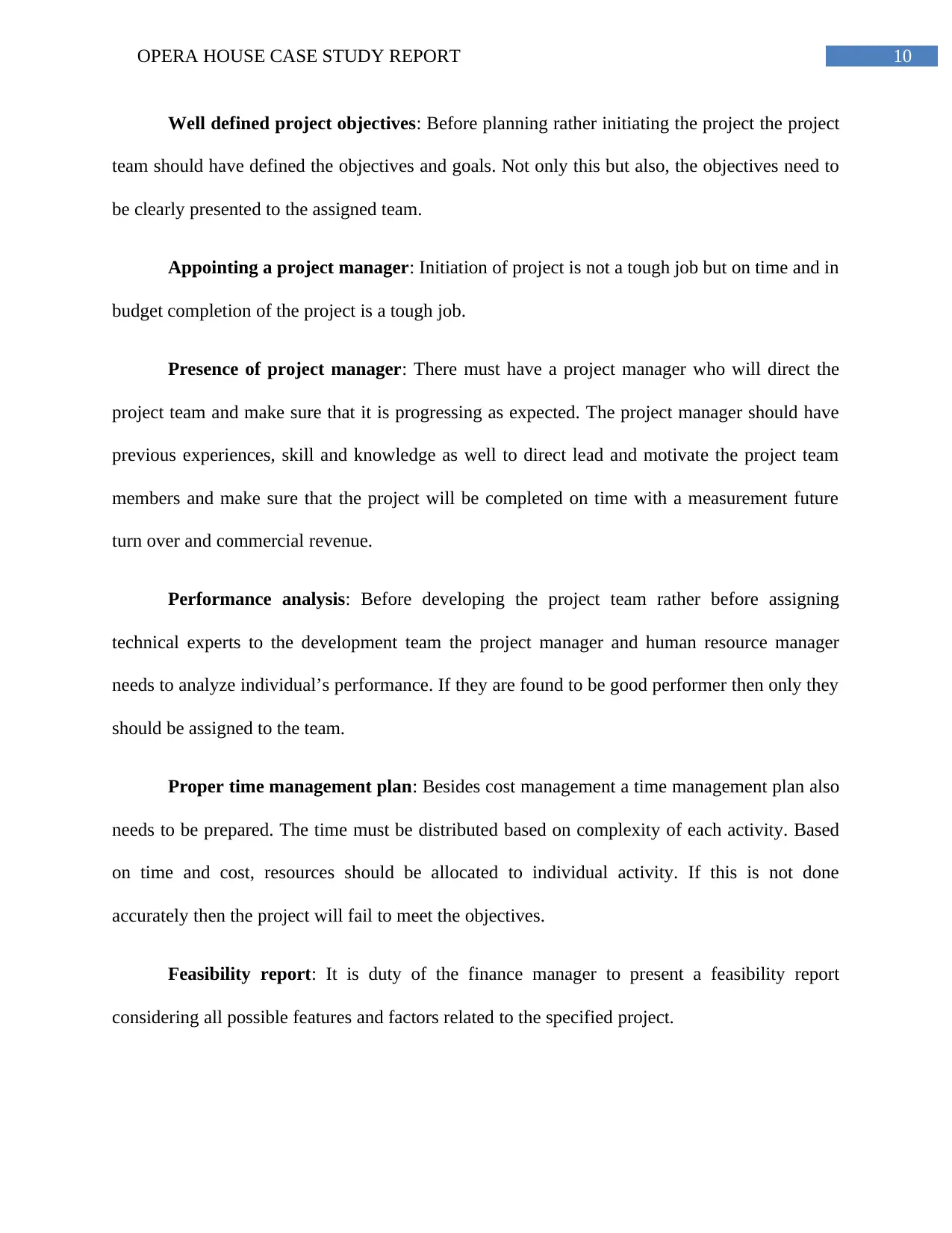
10OPERA HOUSE CASE STUDY REPORT
Well defined project objectives: Before planning rather initiating the project the project
team should have defined the objectives and goals. Not only this but also, the objectives need to
be clearly presented to the assigned team.
Appointing a project manager: Initiation of project is not a tough job but on time and in
budget completion of the project is a tough job.
Presence of project manager: There must have a project manager who will direct the
project team and make sure that it is progressing as expected. The project manager should have
previous experiences, skill and knowledge as well to direct lead and motivate the project team
members and make sure that the project will be completed on time with a measurement future
turn over and commercial revenue.
Performance analysis: Before developing the project team rather before assigning
technical experts to the development team the project manager and human resource manager
needs to analyze individual’s performance. If they are found to be good performer then only they
should be assigned to the team.
Proper time management plan: Besides cost management a time management plan also
needs to be prepared. The time must be distributed based on complexity of each activity. Based
on time and cost, resources should be allocated to individual activity. If this is not done
accurately then the project will fail to meet the objectives.
Feasibility report: It is duty of the finance manager to present a feasibility report
considering all possible features and factors related to the specified project.
Well defined project objectives: Before planning rather initiating the project the project
team should have defined the objectives and goals. Not only this but also, the objectives need to
be clearly presented to the assigned team.
Appointing a project manager: Initiation of project is not a tough job but on time and in
budget completion of the project is a tough job.
Presence of project manager: There must have a project manager who will direct the
project team and make sure that it is progressing as expected. The project manager should have
previous experiences, skill and knowledge as well to direct lead and motivate the project team
members and make sure that the project will be completed on time with a measurement future
turn over and commercial revenue.
Performance analysis: Before developing the project team rather before assigning
technical experts to the development team the project manager and human resource manager
needs to analyze individual’s performance. If they are found to be good performer then only they
should be assigned to the team.
Proper time management plan: Besides cost management a time management plan also
needs to be prepared. The time must be distributed based on complexity of each activity. Based
on time and cost, resources should be allocated to individual activity. If this is not done
accurately then the project will fail to meet the objectives.
Feasibility report: It is duty of the finance manager to present a feasibility report
considering all possible features and factors related to the specified project.
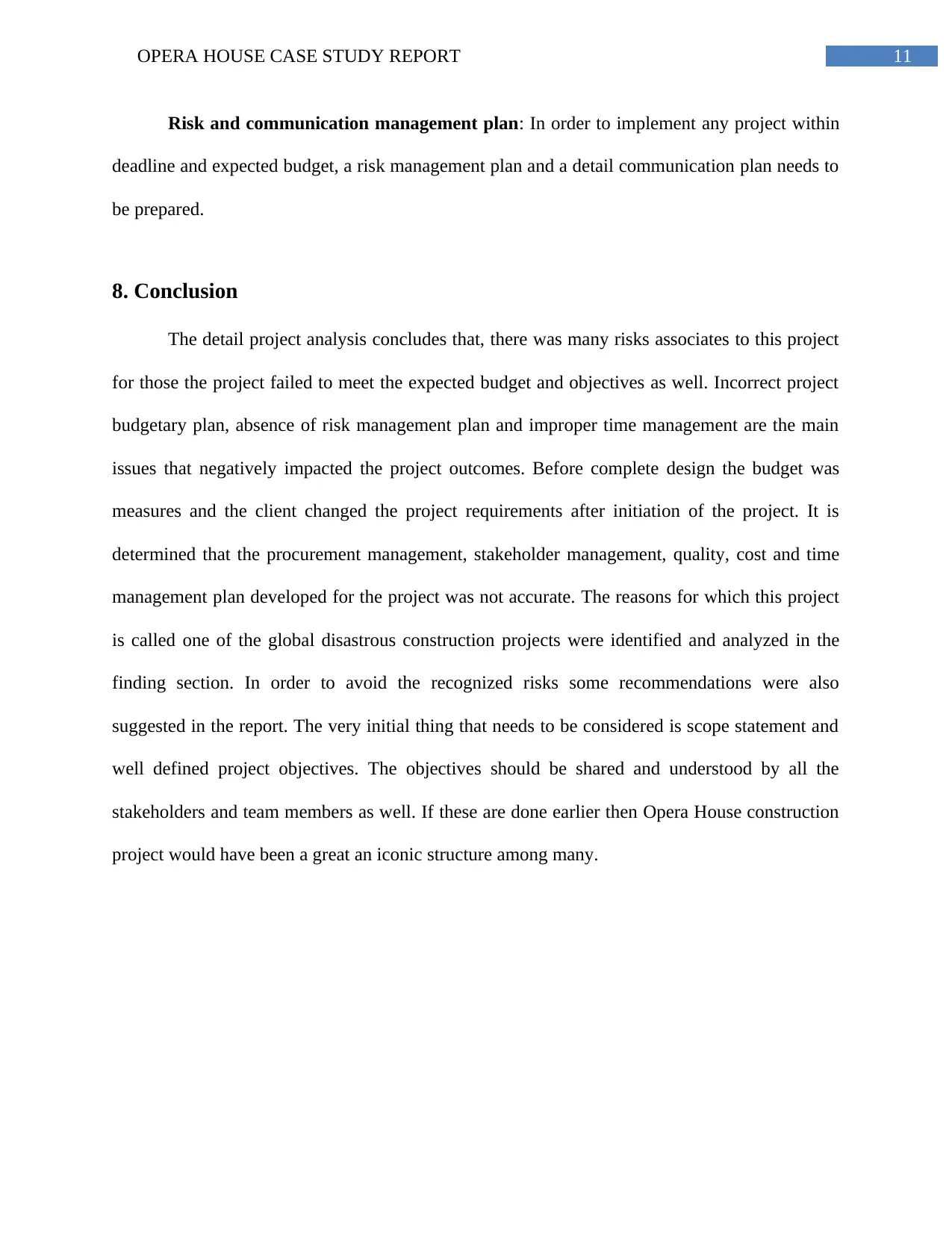
11OPERA HOUSE CASE STUDY REPORT
Risk and communication management plan: In order to implement any project within
deadline and expected budget, a risk management plan and a detail communication plan needs to
be prepared.
8. Conclusion
The detail project analysis concludes that, there was many risks associates to this project
for those the project failed to meet the expected budget and objectives as well. Incorrect project
budgetary plan, absence of risk management plan and improper time management are the main
issues that negatively impacted the project outcomes. Before complete design the budget was
measures and the client changed the project requirements after initiation of the project. It is
determined that the procurement management, stakeholder management, quality, cost and time
management plan developed for the project was not accurate. The reasons for which this project
is called one of the global disastrous construction projects were identified and analyzed in the
finding section. In order to avoid the recognized risks some recommendations were also
suggested in the report. The very initial thing that needs to be considered is scope statement and
well defined project objectives. The objectives should be shared and understood by all the
stakeholders and team members as well. If these are done earlier then Opera House construction
project would have been a great an iconic structure among many.
Risk and communication management plan: In order to implement any project within
deadline and expected budget, a risk management plan and a detail communication plan needs to
be prepared.
8. Conclusion
The detail project analysis concludes that, there was many risks associates to this project
for those the project failed to meet the expected budget and objectives as well. Incorrect project
budgetary plan, absence of risk management plan and improper time management are the main
issues that negatively impacted the project outcomes. Before complete design the budget was
measures and the client changed the project requirements after initiation of the project. It is
determined that the procurement management, stakeholder management, quality, cost and time
management plan developed for the project was not accurate. The reasons for which this project
is called one of the global disastrous construction projects were identified and analyzed in the
finding section. In order to avoid the recognized risks some recommendations were also
suggested in the report. The very initial thing that needs to be considered is scope statement and
well defined project objectives. The objectives should be shared and understood by all the
stakeholders and team members as well. If these are done earlier then Opera House construction
project would have been a great an iconic structure among many.
⊘ This is a preview!⊘
Do you want full access?
Subscribe today to unlock all pages.

Trusted by 1+ million students worldwide
1 out of 14
Related Documents
Your All-in-One AI-Powered Toolkit for Academic Success.
+13062052269
info@desklib.com
Available 24*7 on WhatsApp / Email
![[object Object]](/_next/static/media/star-bottom.7253800d.svg)
Unlock your academic potential
Copyright © 2020–2025 A2Z Services. All Rights Reserved. Developed and managed by ZUCOL.


